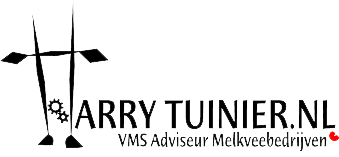October 2024:
Use a high-pressure cleaner?
It is very tempting to occasionally clean the robot with a high-pressure cleaner.
DeLaval is against using a high-pressure cleaner when cleaning the robot.
Because there is too much hardware and also moving parts such as encoders, camera, touchscreen, which can very badly withstand the water pressure of a high-pressure cleaner.
It is protected, but you also want the VMS to last 24/7 for many years.
If you still want to use the high-pressure cleaner for the floor and the fencing, do so with your Farmersense, so with a minimum pressure, at most 80 Bar and pay close attention to what you are spraying.
And make sure that the robot room is well ventilated in the meantime and afterwards.
The splashes go everywhere and the vapor otherwise hangs in the robot room for hours and that is also very bad for the printed circuit boards etc.!
Try to clean as much as possible with the water hose with sprayer in combination with a car wash brush, cleaning cloth, to have to use the high-pressure cleaner as little as possible.
June 2024:
Handy VMS Guidance gate.
The VMS guidance gate has proven its usefulness on many farms when milk
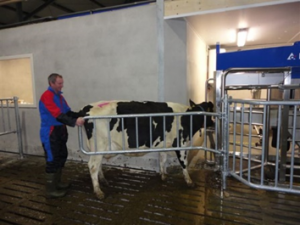
ing new cows and heifers.
However, the production of these fences stops.
So if you still want such a fence, please let us know at harry@harrytuinier.nl
Also see on this Website:
=> VMS Start-up assistance
=> Handy VMS Guidance Gate
May 2024:
Sieves on separation jugs.
It’s getting warmer again and that often means more flies…
It also sometimes splashes happily around the jugs for separation milk, which is a treat for the flies. To prevent splashing and fly nuisance, you can easily place sieves with a diameter of 18 – 20 cm on the
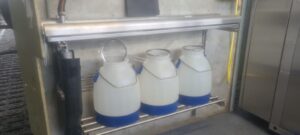
separation jugs. These must be made of metal because then the meshes or wires are thinner and that means less splashing. So no plastic strainers.
November 2023:
Daily cleaning, also slides.
Daily cleaning and checking of the milk cups, hoses and teat clean cup also includes rinsing / brushing and checking the slides, the guides, along which the milk hoses are pulled up and down.
Dirt also easily accumulates here, making it increasingly difficult for the robotarm to get the cups to the right place.
This can easily cause incomplete milkings!
And of course, keep track of the rubber flap that always catches the milk cups.
Cleaning the camera?
Technician’s tip: Fold up a piece of kitchen roll the size of the camera glass, soak it with a little acid and “stick” it to the glass, let it sit for 2 – 3 minutes, then wipe off and rinse the camera well.
October 2023:
Clean teat liners.
When the milking robot is on a flat floor and there is no pit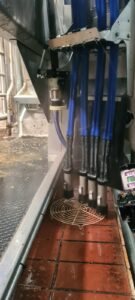 for it, for example, it sometimes happens that during the back-flush, which is the rinse after each milking, the teat cups, or actually teat liners, touch the ground.
for it, for example, it sometimes happens that during the back-flush, which is the rinse after each milking, the teat cups, or actually teat liners, touch the ground.
That place cannot always be kept clean all day and night, so it is not very hygienic.
A solution is to put something simple here that ensures that the teat cups do not touch the ground and that is easy to keep clean.
June 2023:
Manure plate.
More and more often we see that a stainless steel container has been neatly placed around the manure plate behind the VMS.
This looks clean and tidy.
However, it is then more difficult to check whether the manure plate is still doing its job properly, you cannot see whether the manure plate is moving properly when a cow is in the VMS.
Especially on farms with VMS Classics, we do not have to explain how important the proper functioning of the manure plate is. But even with the V300 it still has a function.
So make sure every day that the manure plate moves well, the spring still does its job, the rods are straight and the manure plate is not weighed down by manure. These are all reasons why he moves less, the cow suffers from the manure plate and it is more difficult for the robot to connect.
December 2022
Clean separation cans.
It is sometimes an annoyance when you don’t need a few separation cans for a while that they still get dirty and often smell.
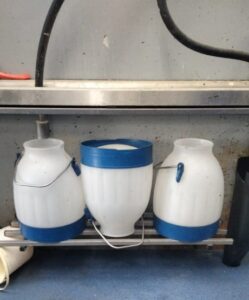 Get in the habit of cleaning the jugs that are not being used and simply place them upside down between or next to them. Also rotate these jugs so that they do not become or remain “chronically” dirty.
Get in the habit of cleaning the jugs that are not being used and simply place them upside down between or next to them. Also rotate these jugs so that they do not become or remain “chronically” dirty.
DeLaval does the same with the teat cups and pre-treatment cup. After each milking upside down and rinse. Even after cleaning, they hang upside down so that dirt or milk residues as little as possible can mean something.
November 2022:
Sufficient pressure on water hose.
In almost every robot room there is a water sprayer and there is a place where a brush, cloth, roll of soft paper, cleaning agent such as antikal and other frequently used cleaning material.
If it’s close by and works well, it’s more likely to be used.
Very often there is only little pressure on the water hose or is too short, so when you rinse it you only clean it half, or half far.
“It doesn’t matter, I’ll go over it every now and then with the pressure washer”…
Nevertheless, it works very pleasantly if there is sufficient pressure, because at the intervals, cleaning quickly, you keep track of it much better. And when you rinse the VMS cups and frame (daily?) with a car wash brush, it is nice if enough water comes out!
Perhaps the high-pressure sprayer is needed just a little less often, which is good for the printed circuit boards and other vulnerable parts…
July 2021:
Radio on in the stable?
Radio on in the barn and with the robots gives peace of mind. Quiet music, but always noise, makes the animals less startled by strange noises, strange people, etc.
And cheerful music also often makes for a happier farmer
And cows notice that !!
March 2021:
Buffer tank.
It seems like an advertising tip.
The cleaning of the milking robot takes place at the same time every day and is therefore a stable factor in the farm and cows rhythm. Emptying the milk cooling tank is done once every 2 to 3 days. But this causes rhythm disturbances every time.
Emptying and especially cleaning the tank quite a bit of time is lost, and the cows that want and may be milked again are not able to do so.
When the cleaning is finished, other cows will come already and they also have milk permission again.
And so it accumulates.
And who are the victims again, who keep getting out of their rhythm?
Right! The (new) heifers and low-ranking cows….
A buffer tank solves this.
September 2020:
The Frequency Regulator
The frequency regulator has a filter at the bottom, which is usually cleaned during service, but with this warm weather, sometimes it is necessary to clean it more often.
Just like an extra check of the compressor’s air filter and the grid of the cooler of the milk tank.
If they get enough fresh air, you will save on disruptions and electricity costs, especially in warm weather!
July 2020:
Keep the entry and exit gates clean.
Although the VMS has a floor cleaner, it is wise to spray off the corners a few times a day, on the places where the floor cleaner does not keep clean enough.
While you’re doing that, you might as well clean the lower bars of the entrance and exit gates too. Manure crusts builds easily here. That does not look neat, but above all: if you decide, on a rainy day, to give the VMS and space a good cleaning, everything will shine for you again, but also for the cow!
If the difference is too great with compared to before cleaning, many cows will hesitate to quickly enter the VMS again.
By keeping more parts of the VMS clean on a daily basis, after a thorough cleaning the difference will not be so great and will thereby decrease changes in visiting behavior!
October 2017:
Cleaning VMS “Eyes”.
The Visolux camera in the VMS monitors when a cow arrives in the system. This camera can get dirty quite quickly. Also, in the Smartgates (Selection port), a camera is keeping track of which cow arrives in the system. (It is hidden in the most recent version of Smartgate.)
The new Body Condition Score (BCS) camera can deliver abundant and explicit information, but only if it has a good field of vision.
To keep the camera’s clean, wipe them regularly down with a damp rag.
Side note: use degreasing supplies.
June 2017:
Spraying on the teat.
It seems logical, but the disinfectant spray that you apply on the teats after every milking session must applied correctly. Now that the fans are blowing at full speed and the windbreakers are completely open, it’s not uncommon that the spray is blown away before it even hits the teat.
If the spray doesn’t find itself on the teats, look at why that might be the case. If it’s the fans’ fault then remove or reposition them.
However, that might result in quite an uncomfortable situation because the flies would be a terrible nuisance underneath the cows.
It sometimes also happens that the spray nozzle, a little or completely, is blocked.
Or the spray track can not be adjusted properly either, the technician can adjust this.
In the case that this issue happens just by some cows, I’d suggest chancing the spray settings for these particular cows to “Normal” or even “Economic”.
February 2017:
Manure plate
The manure plate in the VMS is a crucial component of the system. Not only does it make sure that the VMS’s floor stays clean because it drains urine and manure which keeps the box cleaner, but is also an important indicator to track a cow’s movements to ensure the system attaches the teats more easily.
Note that the cow should stand against the manure plate to ensure it moves with it. Also make sure that the cow does not have too much or too little space. This way, you know for sure that the manure plate gives the VMS arm accurate information.
De manure plate rests on the dirtiest and most vulnerable spot of the VMS. It moves close to 24 hours a day, 7 days a week. There’s a chance that the plate does not work properly by following the movements of the cow which in return yields inaccurate information.
You can spot this when the cow pee’s. You’ll notice that the manure plate does not fall (quick enough) forward. Often, the spring is worn out or stretched out. There’s also the possibility that the rod is bent, or too dirty, or plate too dirty.
There are also farms that have a bin around the manure plate, which is very clean and tidy, but you do not see if manure plate moves correctly. It is very important then to check regularly!
November 2016:
Efficiency Sponge.
The VMS has an integrated sponge where the camera passes for cleaning purposes.
We notice sometimes that the sponge is not very clean, but more often we find that the sponge doesn’t brush the camera right.
Note that the camera should hit the sponge perfectly.
Not pressing to much because all it will do is press and not wipe the camera and damage itself. Likewise, make sure that the sponge is not touched too thin, that doesn’t help either.
Additionally, the sponge is often set to wipe too high which causes the cap to be flattened (over the Lasers?), which in return causes the lasers and camera not to be brushed sufficiently and the sponge can’t clean the lower part of the camera. If the camera touches the sponge too low, it will mostly brush the screws, thus missing the lasers, and still wear out quickly..
In both of these cases the sponge is worn out without having done its job well.
On the touchscreen in the menu Teachen you can adjust these settings with the joystick. It is smart to do first an Endpoint Calibration before adjusting other setting.
It is also good to program in PC that the VMS cleans the camera after every milking, it takes no time and gives a clear view on the teats..
The more times a day you rinse the sponge, the cleaner it is, the better job he makes!
(Washing your boots? => wash the sponge!)
August: 2016:
Disinfect camera body.
Our preparation cup washes and stimulates perfectly, but sometimes it happens that afterwards a (front)teat is touched by the camera body.
“Every advantage has its disadvantage”, said Johan Cruijff, but we want to keep the disadvantage to a minimum.
Therefore, it is very wise to not only wash the glass a few times a day, but also the camera body.
It is wisest to clean with a chlorine solution.
Hydrogen peroxide (PeraDis) was also advised, but if it is not thoroughly rinsed, it may lead to corrosion.
With a bucket of chlorine solution, prepared according to the instructions, and a brush on long steel or carwash brush, clean the camera house frequently in order to prevent bacteria transfer during milking.
The rubber flap, preparation cup and other parts can also be cleaned in this fashion.
July 2016:
Opening Entrance Door.
More often than originally thought, the entry gate of the VMS is not situated correctly.
The entry gate is completely adjustable, which gives DeLaval the opportunity to milk with one robot very large cows, from Fleckvieh, Buffalo’s (for Mozzarella) but also very small, thin cows like Jersey’s.
However, cows at your farm will most likely not differ that significantly.
The entry gate can open up to 300 times a day. So, it tends to shift away from its original place.
If the entry gate is too narrow, it means that the sensor on the cylinder does not notice that the cow is far enough in because the gate is not closed enough. You often see this occur with fatter cows. Or maybe because of the feed manger is to far back, that they are pushed too far back in the VMS. It results in the robot not allowing to start milking the cow.
Or the door is set too spacious and then small or young cows can move from left to right too much.
If you have normal or small Holstein cows, then you should be able to stick a hand between the arrow and the entry gate. If you have Fleckvieh or MRIJ cows, then you should be able to stick a fist between the arrow and the entry gate.
April 2016:
Check with light how clean the lens is
A flashlight is very common these days, even more common on smartphones.
Aim the flashlight at the camera, daily, from the side (!) and see if the glass is clean.
Not only where the camera is is important, but also the corners on top from where the main laser and teat laser have to do their job.
April 2015:
Fly nuisance.
It’s getting warmer again!
Are you ready for it?
So are the flies!
Not only are flies a nuisance during milking, they can also easily transfer diseases. What do you do to combat flies?
Some dairymen use maggot control on their grids, or hire a professional to inject the walls with chemicals.
A fan above the VMS could also freshen the air.
Cows love some wind in the summer, flies hate that!!
Fresh air around the VMS would improve conditions nonetheless.
If what you are doing is helping well, don’t be hesitant to share your ideas, it could really help other dairymen!
March 2015:
Easy daily cleaning
Do you have, within reach, water (cold and warm) spray, cleaners, (carwashing) brush and kitchen towels close behind your robot? Then chances are that the visit time per cow in the VMS declines by 30 seconds compared to those who don’t have cleaning materials within reach.
The equipment at hand invites you to keep the important parts clean, even if you are busy.
And that invites the VMS to “do its very best!”.
January 2015:
Saving Power
On your dairy farms are a couple of “power consumers” who deserve attention.
For example the cooling unit, which is not always on a place you walk past daily.
Sometimes the cooling louvers are full of dust or dirt. Maybe the air filters aren’t clean. If this is the case, the cooling capacity could decrease by 30 to 50 percent which means the unit will have to turn on more often.
This results in a higher usage of power and also more wear and tear.
Also the compressor can, unnoticed, consume more power than necessary.
Since DeLaval switched over to more hydraulic system, the compressor doesn’t have be turned on as often. That clearly saves a lot of power.
But if, along the way, there’s a small leak somewhere or pressure is being tapped for something else, you will have to be extra alert for leaks.
Most of the time you don’t notice when the cooling unit or the compressor starts more often.
August 2014:
Generator
Do you currently have a generator?
If so, when was the last time you tested it?
Storm and thunder season has arrived which means that the power could fall out.
But even in our current networks something could occasionally go wrong and then you won’t have any power.
That never works out well, certainly not with milking robots because they must run 24 hours a day!
Testing should actually be twice a year! Will you put it on the calendar?
November 2012:
Good working teat disinfection.
Autumn has made its entrance, and to your hands and face You probably notice that the autumn / winter also deals rougher with your skin. And that happens also with the skin of the teats of the cow!
Last year, especially after the heavy frosts, here and there the teats became quite chapped and that gave that milking was less pleasant for cows and the teat lockers closed less good after milking! This has a few weeks after that resulted in more mastitis!
So please make sure if your disinfection system does its work good: DeLaval can make good programs, but cannot control! Does it spray well, covers well, not (bit) clogged, etc. If it does not spray correct then you must disassemble the nozzle, key 14, and with screwdriver inside, 3 particles apart. Clean this well with hot water and brush or use a small screwdriver to scratch out. And / or with air blowing. Then on touchscreen once testing (VMS Menu => Robot => Service => Start Disinfect Pump), clutter flow out, and then reassemble, metal on plastic so not too tight, “hand tight”.
It is also wise for example, after a disinfection can is empty, to rinse the whole system. Take off the nozzle and the (milk) filter in the can and flush the system with warm water. After that put a new filter on the weight in the can and the disinfection system works perfect again.
Also take care that the system will not get frozen!
And of course it is important what product do you use: it must have good antibacterial, skin care effect and work well with your installation!
One mastitis more or less or cows who like less to be milked because they have sensitive nipples is quickly more expensive than what you save by using inexpensive products.
DeLaval has e.g. “Pro-Active” dip and that has been specially developed.
Should you opt for something else than take care that your choice has the same minimal antibacterial disinfectant and udder care effect!
August 2012:
Cleaning rubber flap
For many farmers is the rubber flap that the teat cups captures a source of irritation to keep clean. And if he is not clean, it is also a source of bacteria and germs.
In addition to our Belgian farmers more, it also can affect the number coli in milk!
A tour along our mechanics gives the following tips:
- A good method is the rubber flap just to inject a solution of Ultra combined detergent.
- Well let soak, then with the brush or similar cleaning.
- Note also the inside.
- At least 1 time a week.
It is ideal when you have hot water available on the hose to the VMS.
Replacing the flap, as he no longer wants to clean or if he’s around / warp. Because then bacteria and germs too settle easily.
Not skimp on, but with good treatment the rubber flap can last years.
May 2012:
Cows too cramped in VMS.
After first day milking with VMS or at the start with new heifers or new cows, it is recommended to close them first a bit tight in the VMS.
If the cows are used to be milked in the VMS that is just not good because:
- They stand not good, quiet and sometimes almost crooked
- They spill more feed
- Especially higher rear teats are more difficult to connect
- With 2 mirrored VMSs on one VMS group, the cow is curved to the left in one VMS and curved to the right in the other …, so the udder is also in a different place and is therefore more difficult to find for the robot.
- VMS starts as backdoor is closed properly and that takes longer. And of course, much longer for large or thick cows.
So make sure that cows stand comfortable and also check that the back door closes correctly, not to narrow or too wide.
The manure plate has to keep moving when the cow stands against it.
February 2012:
VMS Support Gate.
The VMS Support Gate is a useful aid for heifers and cows to guide them quietly into the VMS. During the first day you start with the VMS, but also in the everyday use of the VMS the tool is a welcome addition and provides a lot of work convenience and pleasure. Using the fence one person (alone) is able to learn “new” cows and heifers into the VMS. But it is also useful when there are cows to be milked by priority, for example, a lame cow or cows in heat. Take them behind the gate and you know that she cannot escape or there will no bossy cow come between.
The gate can be mounted without welding and grinding on each (existing) VMS. Using cross-links, the height is variable to adjust, depends on size of cows and is to desire by the farmer. The construction is made of thick-walled tube and fully galvanized.
After use, the fence completely folded back along the existing gate/fence of the VMS, and so takes a minimum space. To click the Support Port on the fence is possible with delivered hooks.
The VMS Support Port costs depend on distance, installation is free.
For more information, more photos, or orders you can contact:
Gregor Gross Bolting, phone: 0031-6-13 15 75 95 or grossbolting@planet.nl
December 2011:
Easy help cleaning VMS with carwash brush
The traditional parlor was cleaned (usually) two times daily. The VMS also has a daily cleaning necessary to be able to continue functioning.
By everyone is now known that camera and the last part of the arm is most sensitive (dirt) part of the robot. The camera needs 3 times a day a check or cleaning for example with “Antikal” (anti-lime?), especially if you have a lot of lime in the water, that causes Limescale and that may not have any chance!
Every time you rinse your boots you also rinse and squeeze the sponge: every time you pass.
And sometimes put a little of a cleaning product or de-lime product on the sponge will help even more. Thus, the camera all day / night gets a small supply cleaning after each milking.
Furthermore the short / long milk tubes also need a daily cleaning routine. VMS wash them off but it does so “with her eyes closed.” The farmer sees the corners and checks.
A useful tool here is a car brush like the Gardena (see figure).
The Teat cleaner cup also can be cleaned this way properly.
And, … everything is in the same time checked for correct functioning!
The caps of the VMS and the robot arm also can be cleaned with this brush perfectly.
Advantage is also that it splashes less than a “normal” hand shower.
You better not clean the camera with a brush, to prevent scratches.
Better is using soft paper towels.



